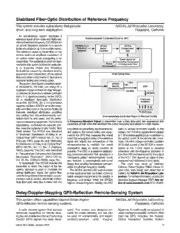
NASA Technical Reports Server (NTRS) 20110024108: Stabilized Fiber-Optic Distribution of Reference Frequency PDF
Preview NASA Technical Reports Server (NTRS) 20110024108: Stabilized Fiber-Optic Distribution of Reference Frequency
Stabilized Fiber-Optic Distribution of Reference Frequency This system includes subsystems that provide NASA’s Jet Propulsion Laboratory, short- and long-term stabilization. Pasadena, California An optoelectronic system distributes a reference signal of low noise and highly sta- Environmentally Controlled Room in SPC bilized phase and frequency (100 MHz) from an atomic frequency standard to a remote 100 MHz From SFODA SFODA facility at a distance up to tens of kilometers. Frequency Master Compensator The reference signal is transmitted to the Standard Controller Reel remote station as amplitude modulation of an optical carrier signal propagating in an Power Supply for optical fiber. The stabilization scheme imple- Controlling Temperature mented in this system is intended particular- Phase of Compensator Reel Compensation ly to suppress phase and frequency fluctuations caused by vibrations and by expansion and contraction of the optical 16-km Optical Fiber fiber and other components in diurnal and seasonal heating and cooling cycles. The system (see figure) comprises sever- SFODA 1 GHz al subsystems, the main one being (1) a Remote CSO Distribution Unit hydrogen-maser or linear-ion-trap frequen- 100 MHz cy standard in an environmentally controlled 100 MHz room in a signal-processing center (SPC), (2) a stabilized fiber-optic distribution Distribution assembly (SFODA), (3) a compensated Amplifiers sapphire oscillator (CSO) in an environmen- tally controlled room in the remote facility, (4) thermally stabilized distribution amplifiers To End Users and cabling from the environmentally con- Environmentally Controlled Room in Remote Facility trolled room to end users, and (5) perfor- mance-measuring equipment. Two of these A Frequency-Standard Signal is transmitted over a long fiber-optic link augmented with subsystems, considered as separate enti- equipment at both ends that stabilizes the output frequency and phase to a high degree. ties, were the subjects of prior NASA Tech long-distance optical fiber), signal retransmis- helps to ensure short-term stability. In this Briefs articles: The SFODA was described sion optics in the remote facility, and equip- system, the 100-MHz signal is first multiplied in “Improved Stabilization of Delay in an ment in the SPC that measures the overall to 1 GHz before applying it as modulation to Optical Fiber” (NPO-19353), Vol, 21, No. 2 round-trip propagation delay of the reference the optical carrier. At the remote site, a low- (February 1997), page 4a; and “Alternative signal and adjusts the temperature of the noise 100-MHz voltage-controlled oscillator for Stabilization of Delay in an Optical Fiber” compensator-reel to maintain the overall (VCO) that is part of the SFODA is phase- (NPO-19075), Vol. 21, No. 2 (February propagation delay as nearly constant as locked to the 1-GHz signal to preserve 1997), page 6a. The CSO was described possible. The CSO is a sapphire-dielectric- coherence with the frequency standard. In in “Temperature-Compensated Sapphire ring microwave resonator that operates in a turn, the CSO is phase-locked to the output Microwave Resonator” (NPO-19414), “whispering-gallery” electromagnetic mode of the VCO. The cleaned-up signal is then Vol. 20, No. 3 (March 1996), page 14a. and features a paramagnetic-spin-tuned measured and distributed to end users. To recapitulate: The SFODA includes the design that provides temperature compen- This work was done by Malcolm transmitter in which the output of the fre- sation for ultrahigh frequency stability. Calhoun, Robert Tjoelker, William Diener, G. quency standard is used to modulate the The SFODA and the CSO work in unison John Dick, Rabi Wang, and Albert Kirk of optical distribution signal, the optical fiber in their environmentally controlled rooms to Caltech for NASA’s Jet Propulsion Lab- used for long-distance transmission, a com- satisfy stringent requirements for stability of oratory. For further information, access the pensator reel (a wound, electrically control- frequency and phase: While the SFODA Technical Support Package (TSP) free on- lable fiber-optic delay line in series with the helps to ensure long-term stability, the CSO line at www.nasatech.comNPO-30490 Delay/Doppler-Mapping GPS-Reflection Remote-Sensing System This system offers capabilities beyond those of prior NASA’s Jet Propulsion Laboratory, GPS-reflection remote-sensing systems. Pasadena, California A radio receiver system that features oped. This system was designed pri- Moreover, it could readily be adapted to enhanced capabilities for remote sens- marily for ocean altimetry, but can also utilize navigation-satellite systems other ing by use of reflected Global Positioning be used for scatterometry and bistatic than the GPS, including the Russian System (GPS) signals has been devel- synthetic-aperture radar imaging. Global Navigation Satellite System NASA Tech Briefs, January 2003 15
